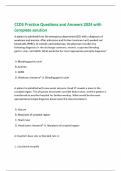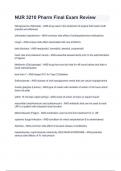CCDS Practice Questions and Answers
2023 with complete solution
A. Bleeding gastric ulcer - A patient is admitted from the emergency department (ED)
with a diagnosis of weakness and anemia. After admission and further treatment with
packed red blood cells (PRBC), GI consult, and endoscopy, the physician includes the
following diagnoses in the discharge summary: anemia, suspected bleeding gastric
ulcer, and GERD. What would be the most appropriate principle diagnosis?
A. Bleeding gastric ulcer
B. Anemia
C. GERD
D. Weakness
B. Neoplasm of occipital region - A patient is admitted with new-onset seizures. Head
CT reveals a mass in the occipital region. The physician documents possible brain
tumor, and the patient is transferred to another hospital for further workup. What would
be the most appropriate principal diagnosis based upon this documentation?
A. Seizure
B. Neoplasm of occipital region
C. Head mass
D. Head tumor
C. 1,2, and 3
1. Calculated annually
2. Dependent upon indirect costs for graduate medical education and new technology
3. Adjusted based upon number of low-income patients cared for - A hospital's base
rate or blended rate is:
1. Calculated annually
2. Dependent upon indirect costs for graduate medical education and new technology
3. Adjusted based upon number of low-income patients cared for
4. Not adjusted based upon capital expenses
A. 1 and 2
B. 2 and 3
C. 1,2, and 3
D. 1,2,3, and 4
D. Reflect the severity of illness (SOI) and resource consumption of the patient's care -
The final MS-DRG assigned to a patient's medical record should:
,A. Reflect the amount of time the physician spent with the patient
B. Depend upon the patient's length of stay
C. Be assigned by the physician
D. Reflect the severity of illness (SOI) and resource consumption of the patient's care
C. Poisoning - A patient is admitted from the emergency department with the diagnosis
of acute respiratory failure due to overdose of pain medication and an aspiration
pneumonia. What is the principal diagnosis?
A. Acute respiratory failure
B. Aspiration pneumonia
C. Poisoning
D. Adverse effect of medication
D. All of the conditions should be coded - A patient is admitted with pneumonia, stage 1
chronic renal failure, chronic anemia, and COPD, While hospitalized the patient
receives IV antibiotics, inhalers, oxygen, IV fluids at 50mL/hr, and iron tablets. Keeping
the guidelines for coding of secondary diagnoses in mind, which condition should be
coded?
A. Pneumonia only
B. Pneumonia and COPD only
C. Pneumonia, COPD, and anemia
D. All of the conditions should be coded
D. Fractured ulna - Which of the following is an example of a hospital-acquired
condition?
A. Fat embolism
B. IV phlebitis
C. Pneumonia
D. Fractured ulna
C. A diagnosis that is listed as possible in the history and physical - Which of the
following is an example of documentation that would meet the present on admission
criteria for coding?
A. A diagnosis that is indicated in the history and physical and ruled out in the discharge
summary
B. A diagnosis found in a previous medical record
C. A diagnosis that is listed as possible in the history and physical
D. An acute condition identified on the third day of admission
A. Colon cancer - A patient is admitted with abdominal pain and the history and physical
indicated a diagnosis of probable colon cancer. On day two, the physician documents
acute renal failure in the progress notes and the patient receives IV fluids. The
,discharge summary lists possible metastatic colon cancer and acute renal failure. The
principal diagnosis would be:
A. Colon cancer
B. Acute renal failure
C. Abdominal pain
D. Metastatic neoplasm of the colon
D. 1,2, and 3
1. Include identification of the patient's SOI
2. Identify conditions that are present on admission
3. Support medical necessity - Accurate documentation should:
1. Include identification of the patient's SOI
2. Identify conditions that are present on admission
3. Support medical necessity
A. 1 and 2
B. 2 and 3
C. 1 and 3
D. 1,2, and 3
B. Anemia - A patient with a history of metastatic lung cancer is directly admitted from
the doctor's office with a diagnosis of anemia secondary to chemotherapy. The patient
receives two units of PRBCs and is discharged. What is the most appropriate principal
diagnosis?
A. Respiratory neoplasm
B. Anemia
C. Admission for chemotherapy
D. Admission for blood transfusion
A. GI hemorrhage - A patient is admitted from the ED with rectal bleeding secondary to
Coumadin toxicity. The physician documents that the patient had a recent increase in
Coumadin dosage due to low PT/PTT. The patient also has a history of COPD and
CHF. What is the most appropriate principal diagnosis?
A. GI hemorrhage
B. Coumadin toxicity
C. COPD
D. CHF
C. Infected knee prosthesis - A patient comes to the ED with fever, chills, and knee
pain. Documentation states that the patient's admission is for knee prosthesis removal
due to infection. What is the principal diagnosis? (Do not include the procedure)
,A. Fever
B. Sepsis
C. Infected knee prosthesis
D. Knee pain
D. Septic joint - A patient is admitted with pain in the lower extremity. The physician
documents cellulitis due to septic joint. X-ray indicates possible osteomyelitis. What is
the principal diagnosis?
A. Pain
B. Cellulitis
C. Osteomyelitis
D. Septic joint
D. A sign and symptom code should only be used if no definitive diagnosis is
determined. - Which guideline provides the direction for the correct assignment of the
principal diagnosis?
A. Probable/possible conditions should always be assigned over a symptom diagnosis
B. Always code the most severe condition as principal
C. The coder can link the symptom to the most appropriate condition
D. A sign and symptom code should only be used if no definitive diagnosis is
determined
D. Utilize a combination code with the individual codes listed as secondary - A patient is
admitted with hypertensive heart failure and chronic kidney disease (CKD). Appropriate
code assignment would:
A. Identify individual codes for each condition
B. Identify the most appropriate combination code
C. Require a query for a link between the conditions
D. Utilize a combination code with the individual codes listed as secondary
D. 1,2, and 3
1. Coding guidelines stating that if two conditions meet the criteria for principal
diagnosis, either condition can be sequenced first
2. Coding guidelines indicating chapter-specific guidelines
3. Understanding of the UDHHS definition of a principal diagnosis - A patient is admitted
with exacerbation of COPD, acute respiratory failure, and acute renal failure.
Appropriate sequencing of the conditions would be based upon:
1. Coding guidelines stating that if two conditions meet the criteria for principal
diagnosis, either condition can be sequenced first
2. Coding guidelines indicating chapter-specific guidelines
,3. Understanding of the UDHHS definition of a principal diagnosis
A. 1 and 2
B. 2 and 3
C. 1 and 3
D. 1,2, and 3
D. 2,4, and 5
2. ICD-10 code B20 should only be assigned in confirmed cases of HIV
4. ICD-10 code B20, if sequenced as a secondary diagnosis, qualifies as an MCC
5. Coding is specific to the reason for admission - Which of the following are included in
chapter-specific guidelines for the coding of HIV?
1. ICD-10 code B20 should be sequenced as principal diagnosis in all cases
2. ICD-10 code B20 should only be assigned in confirmed cases of HIV
3. HIV status must be confirmed by a blood test
4. ICD-10 code B20, if sequenced as a secondary diagnosis, qualifies as an MCC
5. Coding is specific to the reason for admission
A. 1,2, and 3
B. 1,3, and 5
C. 2,3, and 4
D. 2,4, and 5
A. The systemic infection is always sequenced as principal diagnosis - Appropriate
sequencing for a patient with urinary tract infection (UTI), pneumonia, and sepsis, all
present on admission, recognizes that:
A. The systemic infection is always sequenced as principal diagnosis
B. The systemic infection is always sequenced as secondary diagnosis
C. The ICD-10 code for SIRS should be sequenced as principal diagnosis
D. Documented organ failure is necessary before one can code sepsis
C. Bone metastasis - A patient is admitted with back pain documented as secondary to
metastatic colon cancer. During the hospitalization, the patient undergoes a bone scan
and the physician documents new bone metastasis of the spine. An oncology consult is
completed and radiation therapy is recommended. The patient refuses further care,
receives pain control, and is then discharged to hospice. The principal diagnosis is:
A. Metastatic colon cancer
B. Pain
C. Bone metastasis
D. Palliative care
C. 1 and 4
, 1. Documentation of Type 1 or Type 2 diabetes
4. Documentation of any manifestations of the diabetes - When coding a medical record
that includes diabetes and manifestations of diabetes, it is important to remember that
specificity of coding for diabetes is dependent upon:
1. Documentation of Type 1 or Type 2 diabetes
2. Documentation of whether the diabetes is controlled
3. Documentation of the patient's blood sugar levels
4. Documentation of any manifestations of the diabetes
A. 1,2, and 3
B. 1,2, and 4
C. 1 and 4
D. 2 and 4
C. A condition that remains or develops after conclusion of the acute phase of an
illness/injury - A late effect of a condition is defined as:
A. A condition that develops within a year of the original condition
B. A condition that always occurs
C. A condition that remains or develops after conclusion of the acute phase of an
illness/injury
D. A condition that occurs as a complication of surgery
D. The ulcer would not be coded as the physician has not provided its etiology or
location - A patient is admitted from a nursing home with pneumonia. Nursing notes
identify a decubitus ulcer that is described as a stage 3 ulcer of the sacrum. The
physician documentation does not indicate the ulcer, but a wound care consult is
ordered and a wound vacuum is placed. Which of the following statements is accurate?
A. The ulcer would not be coded as it is a hospital-acquired condition
B. The ulcer would be coded as an MCC to the pneumonia
C. The ulcer would be coded as principal diagnosis
D. The ulcer would not be coded as the physician has not provided its etiology or
location
A. 1,2, and 3
1. Ensure that each medical record accurately reflects the patient's SOI and the
resource consumption of the admission
2. Provide physicians with necessary information so they can better understand coding
guidelines
3. Assist in the accurate coding of diagnoses being monitored and treated - The
purpose of a concurrent query is to:





